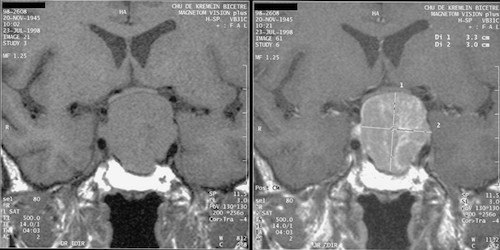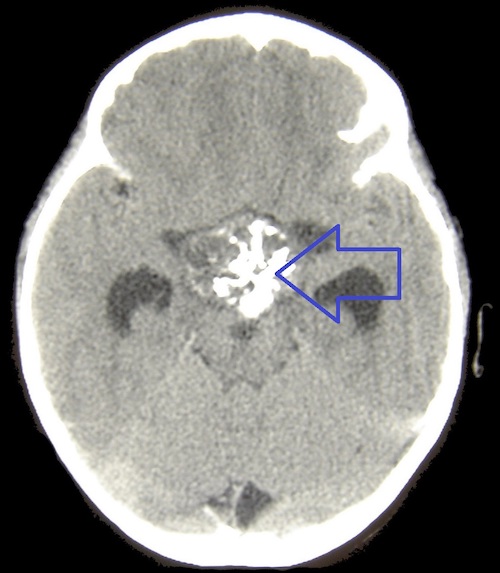Endocrine: Pituitary Pathology
Pituitary Adenoma
Classification
- Function:
- Nonfunctional (Generally Present as Clinically Nonfunctioning with Rare Symptoms from Hormone Hypersecretion)
- Gonadotroph Adenoma
- Thyrotroph Adenoma
- Functional – Most Common
- Lactotroph Adenoma
- Somatotroph Adenoma
- Corticotroph Adenoma
- Nonfunctional (Generally Present as Clinically Nonfunctioning with Rare Symptoms from Hormone Hypersecretion)
- Size:
- Microadenoma (< 1 cm)
- Macroadenoma (≥ 1 cm)
- Giant (> 4 cm)
Symptoms of Mass Effect
- Headache
- Bitemporal Hemianopia – From CN II Compression
- Mildly Decreased Hormone Release
Diagnosis
- Dx: MRI & Hormonal Labs
- Hormonal Evaluation:
- Lactotroph Adenoma: Serum Prolactin > 200 ng/mL
- Somatotroph Adenoma: Serum Insulin-Like Growth Factor 1 (IGF-1)
- Corticotroph Adenoma: *See Endocrine: Hypercortisolism
- Associated with MEN-1 Syndrome
Nonfunctional Tumor
- Nonfunctional Tumors are Most Commonly Identified as Macroadenomas
- Primarily Present with Symptoms of Mass Effect
- Treatment:
- Symptomatic: Transsphenoidal Resection
- Primary Indications: Impaired Vision or High Risk for Vision Loss
- May Require Adjuvant Radiation
- Asymptomatic: Consider Annual MRI to Monitor vs Surgery
- Symptomatic: Transsphenoidal Resection
Lactotroph Adenoma (Prolactinoma)
- Hypersecretion of Prolactin
- Most Common Functional Adenoma & Most Common Adenoma Overall
- Presentation:
- Females:
- Infertility
- Amenorrhea
- Galactorrhea
- Males:
- Low Libido/Impotence
- Infertility
- Gynecomastia
- Galactorrhea
- Females:
- Treatment:
- Asymptomatic & < 1 cm: Follow with MRI
- Symptomatic or > 1 cm: Medical Treatment – Dopamine Agonist (Bromocriptine or Cabergoline)
- If Fails: Transsphenoidal Resection
Somatotroph Adenoma
- Hypersecretion of Growth Hormone
- Presentation:
- Acromegaly (In Adults)
- Thickened Skin
- Coarse Facial Features & Enlarged Jaw (Macrognathia)
- Enlarged Hands (Need to Enlarge Rings)
- Enlarged Feet (Increased Shoe Size)
- Broad Bones
- Hypertension
- Cardiomyopathy
- Diabetes
- Obstructive Sleep Apnea
- Gigantism (In Peds)
- Dramatic Vertical Growth
- Obesity
- Macrocephaly
- Acromegaly (In Adults)
- Treatment: Transsphenoidal Resection
Corticotroph Adenoma
- Hypersecretion of ACTH (Cushing Disease)
- *See Endocrine: Hypercortisolism

Pituitary Adenoma 1

Acromegaly Facial Features 2

Gigantism 3
Other Pituitary Pathology
Pituitary Apoplexy (“Sudden Attack”)
- Sudden Hemorrhage or Infarction of the Pituitary Gland
- Risk Factors:
- Pituitary Adenoma (Most Common)
- May Occur After Radiation Therapy
- Hypertension
- Major Surgery
- Medications
- Head Trauma
- Pituitary Adenoma (Most Common)
- Presentation:
- Sudden Excruciating Headache
- Diplopia & Decreased Visual Acuity
- Altered Mental Status
- Nausea & Vomiting
- Hormone Deficiencies (Minority are Clinically Significant)
- Hemodynamic Shock – From ACTH Loss
- Diagnosis: MRI/CT
- Treatment: Steroids & IVF
- May Require Surgical Decompression for Severe Vision Changes or Neurologic Symptoms
Sheehan Syndrome
- Pituitary Gland Infarction Due to Postpartum Hemorrhage (Typically Large Losses)
- Pituitary Hypertrophies While Pregnant
- Presentation:
- Lactation Failure (Most Common Symptom)
- Failure to Resume Menses/Amenorrhea
- Lethargy & Fatigue
- Weight Loss
- Hypothyroid
- Treatment: Hormone Replacement
Nelson Syndrome
- Pituitary Gland Hypertrophy After Bilateral Adrenalectomy for Cushing Disease
- Loss of HPA Axis Feedback Causes Increased CRH/ACTH Production
- Generally Occurs 1-5 Years Postoperatively
- Presentation:
- Hyperpigmentation (Most Overt Symptom)
- From ACTH Conversion to CRH
- May Cause a Prominent Linea Nigra from the Pubis to Umbilicus
- Headache
- Diplopia & Decreased Visual Acuity
- Amenorrhea
- Hyperpigmentation (Most Overt Symptom)
- Diagnosis: Increased ACTH After Surgery & MRI
- Primary Treatment: Transsphenoidal Resection
- If Surgery Not an Option: Radiation or Medical Therapy
Craniopharyngioma
- Solid/Cystic Tumor from the Remnant of Rathke’s Pouch
- Rathke’s Pouch: Ectoderm That Becomes Anterior Pituitary
- Presentation (From Mass Effect):
- Headache
- Bitemporal Hemianopia – From CN II Compression
- Mildly Decreased Hormone Release
- Diagnosis: MRI/CT
- Primary Treatment: Transsphenoidal Resection
- May Require Adjuvant Radiation for Residual Disease

Pituitary Apoplexy 4

Craniopharyngioma 5
References
- Chanson P, Salenave S. Wikimedia Commons. (License: CC BY-2.0)
- Chanson, P., Salenave, S. Acromegaly.Orphanet J Rare Dis 3, 17 (2008). Wikimedia Commons. (License: CC BY-2.0)
- de Herder WW. Acromegalic gigantism, physicians and body snatching. Past or present? Pituitary. 2012 Sep;15(3):312-8. (License: CC Not Specified)
- Berg KT, Harrison AR, Lee MS. Perioperative visual loss in ocular and nonocular surgery. Clin Ophthalmol. 2010 Jun 24;4:531-46. (License: CC Not Specified)
- Garnett MR, Puget S, Grill J, Sainte-Rose C. Craniopharyngioma. Orphanet J Rare Dis. 2007 Apr 10;2:18. (License: CC BY-SA-2.0)